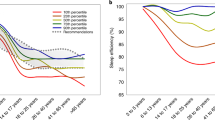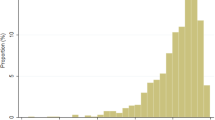Abstract
A large and representative control group is paramount for establishing normative values for sleep in middle-aged persons. However, it is very difficult to recruit normal sleepers. From 286 volunteers who responded to an advertisement for healthy sleepers, only 47 finished the study. We excluded 221 after evaluation of their medical sleep history, general health data, and results of physical examination. We further excluded 18 volunteers after nighttime polysomnography. We finally eliminated from the study 37.5% of the volunteers who entered the screening procedure, on grounds of their sleep disturbances. Our study reveals that investigators face major difficulties when trying to establish a control group of healthy sleepers from the middle-aged population. Sufficient interest on the part of potential test persons does in fact exist, but their general health—and, especially, previously undiscovered sleep disorders—frequently prohibit their inclusion. International and interdisciplinary cooperation is necessary to establish a sufficiently large control group for both clinical and research purposes.
Similar content being viewed by others
INTRODUCTION
In order to evaluate the degree of severity of clinical symptoms, and on general scientific grounds, comparisons are often necessary with healthy control groups. The expense required for the recruitment of such persons, however, is frequently underestimated: a situation that also applies to sleep research.
Although a clear definition of normal sleep exists among young adults (Carskadon and Dement, 2000), accepted criteria or thresholds for the definition of normal sleep among the middle-aged and elderly populations are lacking. Owing to the high current prevalence of sleep disorders within these age groups, and the great economic losses that they occasion (Ancoli-Israel and Roth, 1999; Finn et al, 1998), there is an urgent need for the performance of such studies by sleep physicians.
Toward the recruitment of healthy sleepers to act as controls in our sleep laboratory, we published advertisements calling for middle-aged persons (35–65) without sleep problems. In Germany, the majority of patients suffering from sleep disorders come from this age group—with women, for example, primarily suffering from insomnia (Hajak, 2001) and men from sleep-related breathing disorders (SRBD).
The objective of the present analysis was to establish the proportion of persons who could be included in our sleep study as actually healthy sleepers, as the share of those persons who responded to our advertisement as being interested in taking part in our study.
METHODS
Volunteers for the healthy sleep study who responded to our advertisement were matched in age (±2 years) and gender to already existing patients with sleep disturbances.
In order to reach a relatively representative population, we published our advertisements in government administration offices, in a number of large companies, and in newspapers. Our recruitment did not include the offer of financial reward. It merely stated the conditions of being a healthy sleeper and of being preferably within the age group of 35–65, as well as the requirement of being monitored at night in our sleep laboratory. For a small number of possible test persons, being older than 65 or younger than 35 was not considered an exclusion criterion, insofar as matching was possible.
After initial telephone screening on the basis of a tabular checklist (containing 21 items on sleep and general health), suitable volunteers were invited to the sleep laboratory for thorough clinical examinations. During a detailed interview, we evaluated volunteers' general health (13 items), sleep habits and sleep disorders (24 items), drug intake, as well as the candidates' current clinical status. We performed the appropriate tests, including blood sample analysis, electrocardiograms, pulmonary function tests, and outpatient apnea monitoring in cases of suspected SRBD. If these clinical examinations did not disclose sleep disturbances or factors adversely influencing sleep (eg smoking, alcohol, shift work, or diseases and drugs that disturb sleep), we performed standard polysomnography during two consecutive nights. We visually analyzed the obtained results for sleep (Rechtschaffen and Kales, 1968) and breathing (AASM, 1999) on the basis of standard criteria. Finally, patients with sleep disturbances were excluded from the study. For SRBD persons, an apnea/hypopnea index (AHI) or respiratory arousal index (RAI) greater than 10/h of sleep was sufficient for exclusion from the protocol.
The study protocol was approved by the Ethics Review Committee of the Charité University Medical Center in Berlin, Germany.
RESULTS
Within a period of 4 months, 286 volunteers (155 men, 131 women) from 19 to 68 years of age (mean age±SD: 41±13 years) responded to our advertisement (Figure 1). We excluded 61 volunteers because their age did not satisfy the matching criteria; these exclusions primarily consisted of a large number of interested young people. From the remaining 225, 33 suitable volunteers cancelled their appointments or failed to appear for examination. A total of 100 dropped out after completion of telephone screening, and we excluded another 27 after clinical examination (Table 1).
We consequently excluded 127 volunteers before polysomnographic recording because they were persons from one or more of the following categories (breakdown (Table 1) includes multiple classifications): smokers (26), shift workers (26), volunteers with medical diseases (24), persons with medication that influences sleep (12), persons with pathological symptoms (12), and persons with suspected sleep disturbances (55). Outpatient apnea monitoring was conducted on four volunteers with suspected snoring and daytime sleepiness. Three men had an AHI above 10/h.
The remaining 65 volunteers underwent polysomnographic investigation. After the first night, 17 were excluded owing to objective sleep disturbances: 12 exhibited SRBD with an apnea/hypopnea index greater than 10/h, two demonstrated snoring associated with arousals (RAI above 10/h), three showed periodic leg movements associated with arousals (specific arousal index greater than 10/h), and one volunteer additionally suffered from bruxism. None of the sleep disturbances had been known or suspected in existing medical records.
A total of 47 subjects (27 men, 20 women), mean age 45.1±10.2 years, and mean BMI 24.5±3.2 kg/m2, eventually finished the study. Of all candidates who entered the screening, sleep disturbances dictated that 37.5% (72 of 192) of those who entered the screening be excluded.
DISCUSSION
From 225 volunteers potentially suitable for the control group, only 47 (21%) finished the study with two polysomnographically monitored nights.
In further recruitment, we consequently added the following to our telephone screening on the basis of a tabular checklist (occasioning 44.4% dropouts): a thorough clinical examination (causing 29.3% dropouts), apnea screening for suspicious volunteers, and polysomnographic measurements (occasioning 26.1% dropouts). These procedures have proved to be useful and necessary tools for facilitating inclusion of healthy sleepers in a control group.
We divided the grounds for exclusion into three classes: failure to meet appointments or to satisfy criteria for matching to the experimental group, general recruitment issues, and sleep disturbances. We established that 37.5% of volunteers (72 of 192) who entered the screening suffered from sleeping disorders and therefore did not fulfill the criteria as healthy sleepers. A total of 32.9% (94 of 286) were excluded because of failure to appear or to meet criteria for matching, and 52.6% (101 of 192), due to failure to meet other, general recruitment criteria. It was possible for one patient to simultaneously fail to satisfy a number of different criteria.
The exclusion rate of 37.5% owing to sleep disorders indeed appears excessive, in light of the fact that the volunteers who reported apparently considered themselves healthy sleepers. The rates for the other two exclusion classes are comparable with other studies.
It consequently proved indeed difficult to recruit a group of genuinely healthy middle-aged sleepers, especially since we advertised not for ‘healthy subjects’ but only for ‘healthy sleepers’. The study criteria stipulated that the candidates demonstrate subjectively and objectively undisturbed, normal sleep, as confirmed by polysomnography, which was free from influences, that potentially influence sleep. These influences included the medication and accompanying diseases listed in Table 1.
It must be considered that our study is purely descriptive, and that it was restricted to the local area of Berlin. These limitations of course prevent unrestricted generalization of results. Our findings have nevertheless emphasized the necessity of establishing common inclusion and exclusion criteria for defining such a control group: including the advertisement procedure (which can naturally influence the selection and character of the study population).
The availability of such groups is imperative for scientific evidence-based comparisons between healthy persons and patients with sleep disorders. It would be additionally beneficial to establish by investigation and sampling a large and representative control population of healthy sleepers for application in further studies—that is, a population that would take age, gender, BMI, and race into account. This task represents a scientific challenge for sleep physicians, regardless of their speciality: be it neurology, psychiatry, internal medicine, geriatrics, pediatrics, gynecology, otolaryngology, clinical pharmacology, or preventive and rehabilitative medicine.
References
Ancoli-Israel S, Roth T (1999). Characteristics of insomnia in the United States: results of the 1991 National Sleep Foundation Survey. I. Sleep 22 (Suppl 2): 347–353.
Carskadon MA, Dement WC (2000). Normal human sleep: an overview. In: Kryger MH, Roth T, Dement WC (eds). Principles and Practice of Sleep Medicine, 3rd edn. Saunders: Philadelphia. pp 15–25.
Finn L, Young T, Palta M, Fryback DG (1998). Sleep-disordered breathing and self-reported general health status in the Wisconsin sleep cohort study. Sleep 21: 701–706.
Hajak G (2001). Epidemiology of severe insomnia and its consequences in Germany. Eur Arch Psychiatry Clin Neurosci 251: 49–56.
Rechtschaffen A, Kales A (1968). A manual of standardised terminology: techniques and scoring systems for sleep stages of human subjects. National Institutes of Health: Washington, DC. Publication No. 204, 1968.
The Report of an American Academy of Sleep Medicine (AASM) Task Force (1999). Sleep-related breathing disorders in adults: recommendations for syndrome definition and measurement techniques in clinical research. Sleep 22: 667–689.
Acknowledgements
We thank Frank Donath, Susanne Endres, Martin Glos, Agathe Maurer, and Sabine Quispe Bravo for their kind assistance. The research collaborative Deutsche Forschungsgemeinschaft supported this study (file no.: DFG Fi 584/1-4).
Author information
Authors and Affiliations
Corresponding author
Rights and permissions
About this article
Cite this article
Fietze, I., Diefenbach, K. Healthy Sleepers are Rare: Problems and Success Rates in Establishing a Control Group for Sleep Studies. Neuropsychopharmacol 28, 558–561 (2003). https://doi.org/10.1038/sj.npp.1300082
Received:
Revised:
Accepted:
Published:
Issue Date:
DOI: https://doi.org/10.1038/sj.npp.1300082
Keywords
This article is cited by
-
Daytime baroreflex sensitivity in patients with primary insomnia
Clinical Research in Cardiology (2011)




